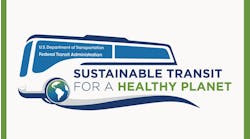The U.S. Department of Transportation’s Federal Transit Administration (FTA) has officially announced the awarding of approximately $75 million to the Utah Transit Authority (UTA) for the construction of the 10.5-mile bus rapid transit (BRT) line connecting the communities of Orem and Provo.
The BRT line is part of the Provo Orem TRIP (Transportation Improvement Project) that has been under construction for the past several months. The project, a partnership between UTA, the Utah Department of Transportation (UDOT), the cities of Provo and Orem and Utah County, is designed to improve transportation for transit riders, drivers, cyclists and pedestrians.
The federal grant will fund about half of the cost of the BRT portion of the project and ensure construction will stay on track to connect the two communities with fast and efficient service.
“UTA is very grateful to the FTA and the U.S. Department of Transportation for their strong support of transit projects in Utah. This grant announcement is the culmination of years of planning with the support and vision of our board, community leaders in Utah County, as well as the support and strong leadership from state lawmakers and Utah’s Congressional delegation,” said UTA President and CEO Jerry Benson.
The BRT line will originate at the Orem Central Station and run to the East Bay Technology Park in Provo, with 18 stops including at Utah Valley University, University Mall, Provo Town Centre Mall, Brigham Young University, downtown Provo and the Provo Central Station. Both Orem and Provo will have stations that feature connections to FrontRunner commuter rail and regular UTA bus routes.
“I am appreciative of the FTA award. There are many cities in the U.S. that have applied for this grant, and there are only a small number that are given out. Mass transit will be important for our community now and in the future,” said Orem Mayor Richard Brunst.
Often referred to as TRAX on rubber tires, BRT will make transit more convenient for Utah County riders. BRT will run every six minutes during peak hours on weekdays and will operate in much the same way as light rail by offering off-board fare collection and elevated platforms to make it easier for passengers to enter and exit the buses. It will run about half of its route in exclusive dedicated lanes down the center of University Parkway in Orem and University Avenue in Provo.
“The Bus Rapid Transit project is one of the pieces we feel continues to answer the greater transportation needs in Utah County,” said Provo Mayor John Curtis.
The FTA funding is provided through its Capital Investment Grant (CIG) Program, the nation’s primary grant program for funding major transit capital investments.
“When completed, the Provo-Orem BRT line will add another important link in Utah’s increasingly comprehensive regional transit system,” said U.S. Transportation Secretary Anthony Foxx. “The Obama Administration is pleased to support a project that will provide quick and efficient transit access to jobs, schools and other opportunities in Utah’s growing Wasatch Front region.”
Projects accepted into the highly competitive CIG program go through a multi-year, multi-step process according to requirements in law to be eligible for and to receive program funds.
“The Provo-Orem BRT line will help create new connections for residents, commuters, and students and faculty traveling to and from the universities and Provo’s bustling downtown,” said FTA Acting Administrator Carolyn Flowers. “This new transportation option will serve an area that is seeing significant job growth, and help the two cities limit traffic congestion and reduce their environmental footprint even as their populations increase.”
Construction of the project is expected to be completed by late-2018 and open to the public by early 2019.




